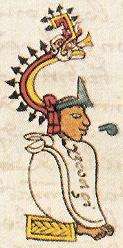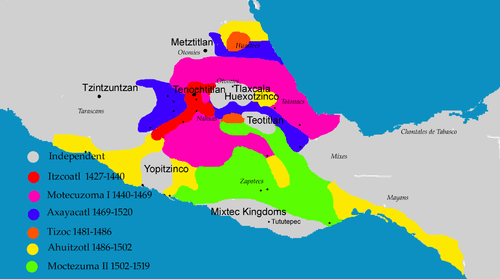Itzcoatl
Itzcoatl (Classical Nahuatl: Itzcōhuātl [it͡sˈkoːwaːt͡ɬ], "Obsidian Serpent", ![]()
| ItzcoatI | |
|---|---|
| 4th Tlatoani of Tenochtitlan First Emperor of the Aztec Triple Alliance | |
Bronze casting done of Itzcoatl by Jesus Contraras in the Garden of the Triple Alliance located in the historic center of Mexico City | |
| Reign | 1427–1440 |
| Predecessor | Chimalpopoca |
| Successor | Moctezuma I |
| Died | 1440 |
| Wife |
|
| Issue | Tezozomoc |
| Father | Acamapichtli |
| Mother | Tepanec woman from Azcapotzalco |
Biography

Itzcoatl was the natural son of tlàtoāni Acamapichtli and an unknown Tepanec woman from Azcapotzalco.[3] He was elected as the king when his predecessor, his nephew Chimalpopoca, was killed by Maxtla of the nearby Tepanec āltepētl (city-state) of Azcapotzalco. Allying with Nezahualcoyotl of Texcoco, Itzcoatl went on to defeat Maxtla and end the Tepanec domination of central Mexico.
After this victory, Itzcoatl, Nezahualcoyotl, and Totoquilhuaztli, king of Tlacopan, forged what would become known as the Aztec Triple Alliance, forming the basis of the eventual Aztec Empire.
Itzcoatl next turned his attention to the chinampas districts on the south shores of Lakes Xochimilco and Chalco. Fresh water springs lining these shores had allowed the development of extensive raised gardens, or chinampas, set on the shallow lake floors. Successful campaigns against Xochimilco (1430), Mixquic (1432), Cuitlahuac (1433), and Tezompa would secure agricultural resources for Tenochtitlan and, along with the conquest of Culhuacan and Coyoacán, would cement the Triple Alliance's control over the southern half of the Valley of Mexico.
With this string of victories, Itzcoatl took the title Culhua teuctli, "Lord of the Culhua" while Totoquilhuaztli, king of Tlacopan, took the title Tepaneca teuctli, "Lord of the Tepanecs".
In 1439, Itzcoatl undertook a campaign outside the Valley of Mexico against Cuauhnahuac (Cuernavaca).
According to the Florentine Codex, Itzcoatl ordered the burning of all historical codices because it was "not wise that all the people should know the paintings".[4][5] Among other purposes, this allowed the Aztec state to develop a state-sanctioned history and mythos that venerated Huitzilopochtli.
Itzcoatl also continued the building of Tenochtitlan: during his reign temples, roads, and a causeway were built. Itzcoatl established the religious and governmental hierarchy that was assumed by his nephew Moctezuma I upon his death in 1440.

Family
Itzcoatl was a son of Acamapichtli and half-brother of Huitzilihuitl. He was an uncle of Chimalpopoca and Moctezuma I.
He married princess Huacaltzintli and had a son Tezozomoc
Notes
- The dominant ethno-political group within the later Aztec political sphere.
- "Itzcóatl, "Serpiente de obsidiana" (1427-1440)" [Itzcóatl, "Obsidian Snake" (1427-1440)]. Arqueologia Mexicana (in Spanish). Retrieved June 6, 2019.
- Itzcoatl's mother is given as a Tepanec woman from Azcapotzalco; see for example Aguilar-Moreno (2007, p. 39).
- Madrid Codex, VIII, 192v, as quoted in León-Portilla, p. 155. Note that León-Portilla finds Tlacaelel to be the instigator of this burning, despite lack of specific historical evidence.
- SilverMoon. "FRAY BERNARDINO DE S AHAGUN AND THE NAHUA: CONFLICTING INTERESTS INTERTWINED" (PDF). scholarworks. Montana State University. Retrieved 5 May 2019.
- Based on the maps by Ross Hassig in "Aztec Warfare"
References
- Aguilar-Moreno, Manuel (2007). Handbook to Life in the Aztec World. Oxford and New York: Oxford University Press. ISBN 978-0-19-533083-0. OCLC 81150666.
- Coe, Michael Coe; Dean Snow; Elizabeth P. Benson (1986). Atlas of Ancient America. New York: Facts on File. ISBN 0-8160-1199-0. OCLC 11518017.
- Hassig, Ross (1988). Aztec Warfare: Imperial Expansion and Political Control. Civilization of the American Indian series, no. 188. Norman: University of Oklahoma Press. ISBN 0-8061-2121-1. OCLC 17106411.
- León-Portilla, Miguel (1963). Aztec Thought and Culture: A Study of the Ancient Náhuatl Mind. Civilization of the American Indian series, no. 67. Jack Emory Davis (trans.). Norman: University of Oklahoma Press. OCLC 181727.
- Weaver, Muriel Porter (1993). The Aztecs, Maya, and Their Predecessors: Archaeology of Mesoamerica (3rd ed.). San Diego, California: Academic Press. ISBN 0-12-739065-0. OCLC 25832740.
External links
| Wikimedia Commons has media related to Itzcoatl. |
| Preceded by Chimalpopoca |
Tlatoani of Tenochtitlan 1427–1440 |
Succeeded by Moctezuma I |